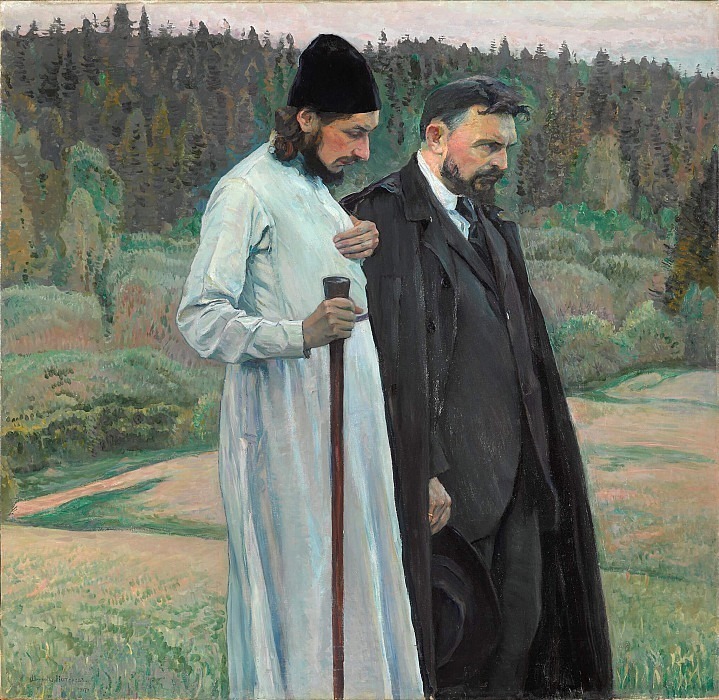Philosophers Mikhail Nesterov (1862-1942)
Mikhail Nesterov – Philosophers
Edit attribution
Download full size: 2048×1994 px (0,4 Mb)
Painter: Mikhail Nesterov
Location: The State Tretyakov Gallery, Moscow (Государственная Третьяковская галерея).
Soviet artist Mikhail Nesterov painted a double portrait, The Philosophers, in 1917. He invited his friends to be the figures for the painting. But they were also prominent people whose religious and philosophical views the artist admired. On the canvas is P. Florensky on the left and the famous S. Bulgakov on the right. The author obviously wished to show the antagonistic nature of his characters.
Description of Mikhail Nesterov’s painting The Philosophers
Soviet artist Mikhail Nesterov painted a double portrait, The Philosophers, in 1917. He invited his friends to be the figures for the painting. But they were also prominent people whose religious and philosophical views the artist admired. On the canvas is P. Florensky on the left and the famous S. Bulgakov on the right.
The author obviously wished to show the antagonistic nature of his characters. First and foremost this is expressed in their clothing. Florensky in the appearance of a priest is dressed in a snow-white cassock; only his modest headdress is black. His companion, Bulgakov, is dressed in a strict black suit with a tie and cloak, and only his shirt collar is white. Another difference between these men is in their facial expressions.
The priest is full of humility and submissiveness, his eyes turned to the ground. This image is the very embodiment of meekness. The man beside him is stubbornly staring ahead. There is a fierce opposition and bold rebellion in his features.
Despite the almost complete contrast of characters, the characters walk side by side as good companions, having a measured conversation.
The fact is that these people are united by something more important - their thoughts about the fate of their native land, their concerns about its long-suffering people. These great thinkers were engaged in a search for truth throughout their lives. Unhurriedly wandering along the path, they are immersed in the solution of important philosophical issues.
Nesterov made a typical Russian landscape as a background for his portrait. Most likely he captured the season of blooming spring. Tall trees, lush bushes and dense grass burned only here and there by the scorching sun.
The painting "The Philosophers" reflects the spiritual vision of the era. Emotions of horror are intertwined with peace and joy. Struggle and confusion transitions to victorious accomplishment. The painter depicted a beautiful peaceful landscape and great thinkers - Bulgakov and Florensky, living the inner life of tireless seekers of truth.
Кому понравилось
Пожалуйста, подождите
На эту операцию может потребоваться несколько секунд.
Информация появится в новом окне,
если открытие новых окон не запрещено в настройках вашего браузера.
You need to login
Для работы с коллекциями – пожалуйста, войдите в аккаунт (open in new window).




















You cannot comment Why?
The subtext of the painting likely revolves around the contrast and dialogue between different ways of thinking or existing in the world. The man in white, reminiscent of a monk or a spiritual seeker, might represent faith, tradition, or an ascetic lifestyle. His attire and demeanor suggest detachment from worldly concerns. The man in dark attire, with his more conventional, secular clothing, could symbolize a more worldly, perhaps intellectual or philosophical, approach. His somber attire and the way he holds his hat might indicate seriousness, contemplation, or even a burden.
The landscape itself, with its rolling hills and dense forest in the background, can be interpreted as representing the vastness of nature, the unknown, or the complexities of life. The path they are walking on, subtly visible, suggests a conscious progression, a step-by-step movement through these broader concepts. The overall mood is one of quiet contemplation and perhaps a shared search for truth or meaning, exploring the complexities of human existence and the diverse paths one might take in understanding the world. The title, Philosophers, explicitly points to this theme of intellectual or spiritual inquiry.